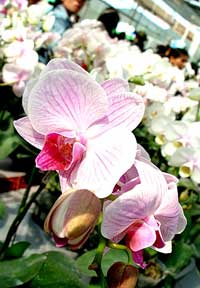Production of growing media for orchids from agricultural residues
 Biologists at Da Lat Nuclear Research Institute have studied and completed the production process of growing orchids from agricultural waste products in Lam Dong.
Biologists at Da Lat Nuclear Research Institute have studied and completed the production process of growing orchids from agricultural waste products in Lam Dong.
Master Nguyen Duy Grade - Head of this research project said: 'The goal we set is to research the production of synthetic substrate for orchids and ornamental plants in Lam Dong from the agricultural residues available. local by biological way to grow orchids and ornamental plants are valuable, in order to replace gradually the natural exploitation as it is gradually depleted. Based on that research, we apply to practical production, to increase flower quality productivity, limit deforestation and improve the environment, improve economic efficiency '.
Thac Nguyen Duy Tu's team used waste products such as bagasse, corn cob, peanut shell, coffee shell, etc., all can be used in the production of organic fertilizers thanks to the preferred microorganisms. heat, capable of resolving these by-products into growing media, not only orchids but also can be applied to a variety of flowers and ornamental plants, replacing traditional media.
In the past 2 years, with the budget for scientific and technological research of Lam Dong province, the authors have been facilitated by the province to research and establish the process of manufacturing synthetic substrates from orchids from agricultural residues by microbial fermentation. This type of synthetic substrate is produced from organic substances with plant sources, aerobic microorganisms and multi-mineral, medium-micro-minerals so it is suitable for growing orchids and flowers, Other bonsai.
This form of synthetic substrate can be produced in tablet or fiber form with nutrient content: 47% organic matter; total nitrogen 0.8%; phosphor 0.7%; total potassium 1%; calcium oxide 0.3%; magnesium oxide 0.3%; S (sulfur) 0.1% and microelements such as Zn, Mo, Mn, Cu, B . In addition, there are also compounds with high biological activity, helping plants have resistance sick. Some useful microorganisms are capable of inhibiting some root pathogens.
 Through experimental results, farming has been successful on many types of plants, especially Cymbidiums at different ages. This can help Cymbidium grow, develop well with well-developed roots, easy to absorb nutrients, appropriate ventilation and water retention.
Through experimental results, farming has been successful on many types of plants, especially Cymbidiums at different ages. This can help Cymbidium grow, develop well with well-developed roots, easy to absorb nutrients, appropriate ventilation and water retention.
Very quick in grasping new techniques, many orchid growers have come to the Department of Biotechnology - Da Lat Nuclear Research Institute proposed to be selected as a pilot model and technology transfer.
Currently, the project is continuing to develop in the direction of a large-scale trial and production project to meet the needs of farmers.
- 'Department of marketing' 'technology for animal feed production and crops from straw and sugarcane leaves
- Some experience growing orchids
- Techniques for growing the scallop orchids in pots
- Research and successfully apply orchid growing on new media
- 43% of greenhouse gases from agricultural activities
- Cut branches, orchid seeds have great benefits
- Unburnt bricks produced from agricultural residues
- Tourists discovered new orchids
- Application of tissue culture to preserve orchids of Kim Diep
- Instructions on how to take care of lake orchid after Tet
- Successful application of nuclear technology in pomelo growing
- Strange orchids, just looking embarrassed
 Why do potatoes have eyes?
Why do potatoes have eyes? 'Tragedy' the world's largest carnivorous life: Death becomes ... public toilet
'Tragedy' the world's largest carnivorous life: Death becomes ... public toilet Tomatoes were once considered 'poisonous' for 200 years
Tomatoes were once considered 'poisonous' for 200 years Detecting microscopic parasites on human face
Detecting microscopic parasites on human face